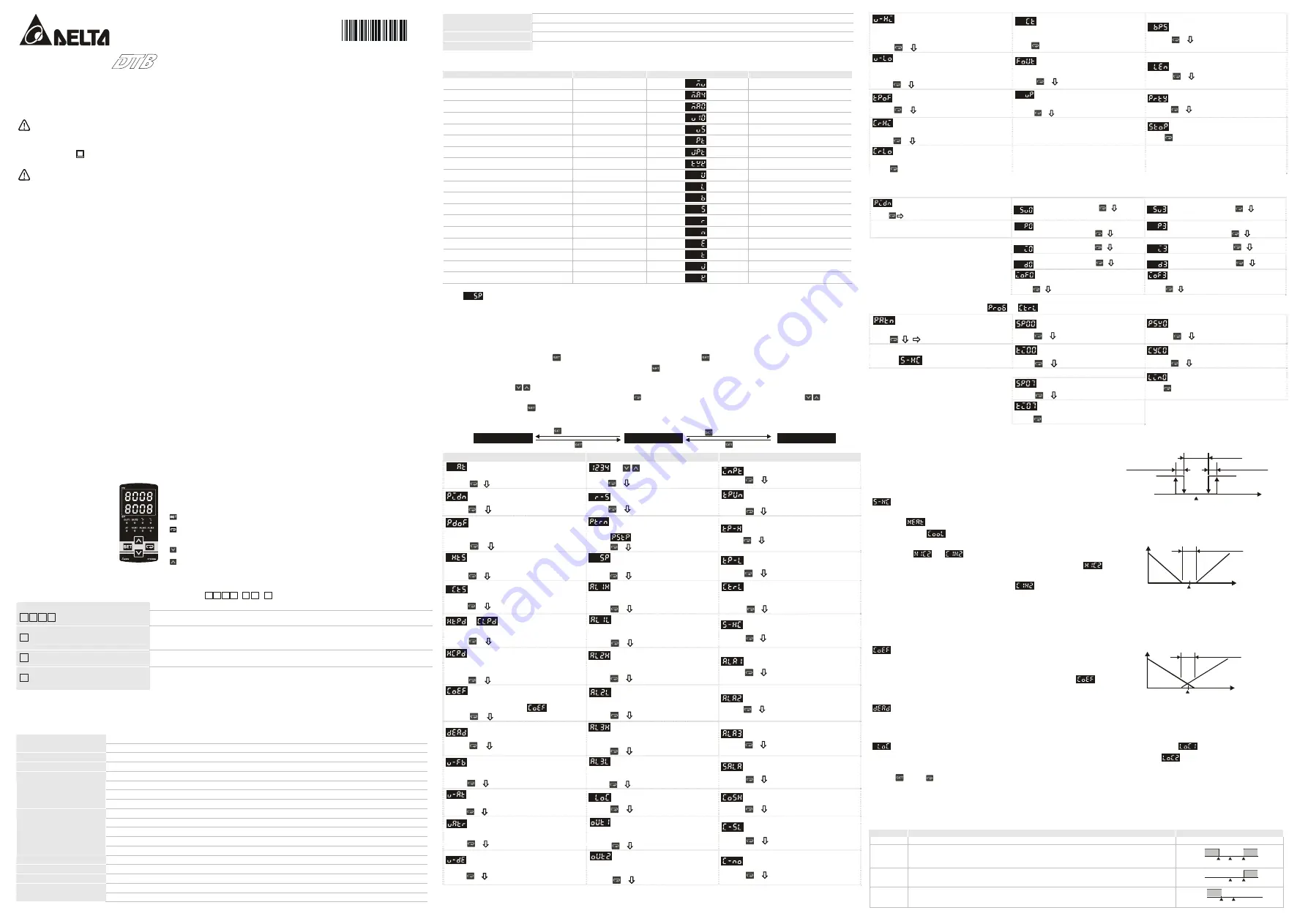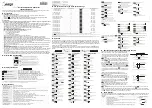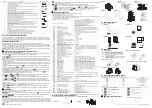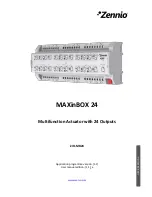
http://www.delta.com.tw/industrialautomation/
5011628704-DBE4
2006-12-19
Series Temperature Controller
Instruction Sheet
Thank you very much for purchasing DELTA B Series. Please read this instruction sheet before using your B series to
ensure proper operation and please keep this instruction sheet handy for quick reference.
Precautions
DANGER! Caution! Electric Shock!
1.
Do not touch the AC terminals while the power is supplied to the controller to prevent an electric shock.
2.
Make sure power is disconnected while checking the unit inside.
3.
The symbol
indicates that this Delta B Series Temperature Controller is protected throughout by DOUBLE
INSULATION or REINFORCED INSULATION (equivalent to Class II of IEC 536).
WARNING!
This controller is an open-type temperature controller. Make sure to evaluate any dangerous application in which
a serious human injury or serious property damage may occur.
1.
Always use recommended solder-less terminals: Fork terminal with isolation (M3 screw, width is 7.0mm (6.0mm for
DTB 4824), hole diameter 3.2mm). Screw size: M3 x 6.5 (With 6.8 x 6.8 square washer). Screw size for DTB4824: M3
x 4.5 (With 6.0 x 6.0 square washer). Recommended tightening torque: 0.4 N.m (4kgf.cm). Applicable wire:
Solid/twisted wire of 2 mm
2
, 12AWG to 24AWG. Please be sure to tighten them properly.
2.
Do not allow dust or foreign objects to fall inside the controller to prevent it from malfunctioning.
3.
Never modify or disassemble the controller.
4.
Do not connect anything to the “No used” terminals.
5.
Make sure all wires are connected to the correct polarity of terminals.
6.
Do not install and/or use the controller in places subject to:
•
Dust or corrosive gases and liquid.
•
High humidity and high radiation.
•
Vibration and shock.
•
High voltage and high frequency
7.
Must turn power off when wiring and changing a temperature sensor.
8.
Be sure to use compensating wires that match the thermocouple types when extending or connecting the
thermocouple wires.
9.
Please use wires with resistance when extending or connecting a platinum resistance thermometer (RTD).
10.
Please keep the wire as short as possible when wiring a platinum resistance thermometer (RTD) to the controller and
please route power wires as far as possible from load wires to prevent interference and induced noise.
11.
This controller is an open-type unit and must be placed in an enclosure away from high temperature, humidity, dripping
water, corrosive materials, airborne dust and electric shock or vibration.
12.
Please make sure power cables and signals from instruments are all installed properly before energizing the controller,
otherwise serious damage may occur.
13.
Please do not touch the terminals in the controller or try to repair the controller when power is applied to prevent an
electric shock.
14.
Wait at least one minute after power is disconnected to allow capacitors to discharge, and please do not touch any
internal circuit within this period.
15.
Do not use acid or alkaline liquids for cleaning. Please use a soft, dry cloth to clean the controller.
16.
This instrument is not furnished with a power switch or fuse. Therefore, if a fuse or power switch is required, install the
protection close to the instrument. Recommended fuse rating: Rated voltage 250 V, Rated current 1 A. Fuse type:
Time-lag fuse
17.
Note: This controller does not provide overcurrent protection. Use of this product requires that suitable overcurrent
protection device(s) must be added to ensure compliance with all relevant electrical standards and codes. (Rated 250
V, 15 Amps max). A suitable disconnecting device should be provided near the controller in the end-use installation.
Display, LED & Pushbuttons
PV Display
SV Display
AT
OUT1/OUT2
Function key
Temperature unit LED
Down key
Up
: to display the process value or parameter type.
: to display the set point, parameter operation read value,
manipulated variable or set value of the parameter.
:
flashes when the Auto-tuning operation is ON.
: Output LED ights when the output is ON.
:
. Press this key to select the desired function mode and
confirm a setting value.
C, F :
.
ALM1 ~ ALM3 : Alarm output LED, lights when ALM1/ALM2/ALM3 is ON.
:
. Press this key to decrease values displayed on the SV
display. Hold down this key to speed up the decrements.
:
O
Auto-tuning LED,
, l
:
. Press this key to set parameters within function mode.
C : Celsius F : Fahrenheit
. Press this key to increase values displayed on the SV display.
Hold down this key to speed up the incremental action.
Mode key
key
O
O
O
Ordering Information
DTB
1 2 3 4 5 6
7
DTB Series
DTB:
Delta B Series Temperature Controller
1 2 3 4
Panel Size (W×H)
4824:
1/32 DIN W48 × H24mm
4896:
1/8 DIN W48 × H96mm
4848:
1/16 DIN W48 × H48mm
9696:
1/4 DIN W96 × H96mm
5
1st Output Group Selection
R:
Relay output, SPDT (SPST: 1/16 DIN and 1/32 DIN size), 250VAC, 5A
V:
Voltage pulse output, 14V +10
﹪
~ -20
﹪
(Max. 40mA)
C:
DC current output , 4 ~ 20m A
L:
Linear voltage output, 0~5V, 0~10Vdc
6
2nd Output Group Selection
R:
Relay output, SPDT (SPST: 1/16 DIN and 1/32 DIN size), 250VAC, 5A
V:
Voltage pulse output, 14V +10
﹪
~ -20
﹪
(Max. 40mA)
7
EVENT Inputs / CT function (Optional)
None:
No EVENT input , No CT (Current transformer)
E:
EVENT input is provided, No CT (Current transformer)
T:
CT (Current transformer) is provided, No EVENT input
V:
Valve control.
Note 1:
DTB4824 series: no optional function provided and no extra alarm output supported, but user can set 2nd output as alarm mode.
Note 2:
DTB4848 series: only one alarm output when optional function supported, but user can set 2nd output as 2nd alarm output.
Note 3: “Valve control” with feedback selection is only available for DTB4896RRV, DTB9696RRV.
Specifications
Input Voltage
100 to 240VAC 50/60Hz
Operation Voltage Range
85% to 110% of rated voltage
Power Consumption
5VA max.
Memory Protection
EEPROM 4K bit (non-volatile memory (number of writes: 100,000)
Display Method
2 line x 4 character 7-segment LED display Process value(PV): Red color, Set point(SV): Green color
Thermocouple: K, J, T, E, N, R, S, B, L, U, TXK
3-wire Platinum RTD: Pt100, JPt100
Sensor Type
Analog input: 0 ~ 5V, 0 ~ 10V, 0 ~ 20 m A, 4 ~ 20 m A, 0 ~ 50mV
Control Mode
PID, ON/OFF, Manual or PID program control (Ramp/Soak control)
Relay output: SPDT (SPST: 1/16 DIN and 1/32 DIN size), Max. load 250VAC, 5A resistive load
Voltage pulse output: DC 14V, Max. output current 40mA
Current output: DC 4 ~ 20m A output (Load resistance: Max. 600
Ω
)
Control Output
Linear voltage output: 0 ~ 10V
Display Accuracy
0 or 1 digit to the right of the decimal point (selectable)
Sampling Rate
Analog input: 150 msec/ per scan Thermocouple or Platinum RTD: 400 msec/per scan
RS-485 Communication
MODBUS ASCII / RTU communication protocol
Vibration Resistance
10 to 55Hz, 10m/s
2
for 10min, each in X, Y and Z directions
Shock Resistance
Max. 300m/ s
2
, 3 times in each 3 axes, 6 directions
Ambient Temperature
0
o
C to +50
o
C
Storage Temperature
-20
o
C to +65
o
C
Altitude
2000m or less
Relative Humidity
35% to 80% (non-condensing)
Temperature Sensor Type & Temperature Range
Input Temperature Sensor Type
Register Value
LED Display
Temperature Range
0 ~ 50mV Analog Input
17
-999 ~ 9999
4 ~ 20mA Analog Input
16
-999 ~ 9999
0 ~ 20mA Analog Input
15
-999 ~ 9999
0V ~ 10V Analog Input
14
-999 ~ 9999
0V ~ 5V Analog Input
13
-999 ~ 9999
Platinum Resistance (Pt100)
12
-200 ~ 600
o
C
Platinum Resistance (JPt100)
11
-20 ~ 400
o
C
Thermocouple TXK type
10
-200 ~ 800
o
C
Thermocouple U type
9
-200 ~ 500
o
C
Thermocouple L type
8
-200 ~ 850
o
C
Thermocouple B type
7
100 ~ 1800
o
C
Thermocouple S type
6
0 ~ 1700
o
C
Thermocouple R type
5
0 ~ 1700
o
C
Thermocouple N type
4
-200 ~ 1300
o
C
Thermocouple E type
3
0 ~ 600
o
C
Thermocouple T type
2
-200 ~ 400
o
C
Thermocouple J type
1
-100 ~ 1200
o
C
Thermocouple K type
0
-200 ~ 1300
o
C
Note 1:
An internal 249
Ω
precision resistor for the current input is built-in, please refer to the item “How To Set Up Current Input”.
Note 2:
(Operation mode) must be set if user wish to specify decimal point position. Except for the thermocouple B, S, R type, the decimal point positions of all
the other thermocouple type input sensors can be set.
The default range of analog input is -999 ~ 9999. For example, when a 0 ~ 20mA analog input is selected as the input temperature sensor type, -999 indicates 0mA and
9999 indicates 20mA. If change the input range to 0 ~ 2000, then 0 indicates 0mA and 2000 indicates 20mA. One display scale is equal to 0.01mA.
Operation
There are three modes of operation: operation, regulation and initial setting. When power is applied, controller gets into
the operation mode. Press the
key to switch to regulation mode. If the
key is pressed for more than 3 seconds,
controller will switch to the initial setting mode. Pressing the
key while in the regulation mode or initial setting mode,
forces the controller to return to the operation mode. PV/SV: Sets the temperature set point and displays the temperature
process value. Use
keys to set the temperature set point.
Setting method: While in any function mode, press the
key to select the desired function and use the
keys to
change settings. Press
key to save the changes. The next flow chart shows how to switch for settings and internal
functions:
Regulation Mode
Operation Mode
Initial Setting Mode
Press key less than 3 sec
Press key
Press key more than 3 sec
Press key
Regulation Mode
Operation Mode
Initial Setting Mode
Auto-tuning
(Set in PID control and RUN mode)
Press
Use key to
set temperature set point
Press
Set input type
Press
4 groups PID modes (n=0~3). When n=4,
PID control is auto regulated.
Press
Press
Control setting RUN or STOP
Set temperature unit
do not display when analog input
Press
PD control offset
setting
(When PID control is ON and Ti=0,
set the value of PdoF.
Press
Start pattern setting (PID
program control and
Time setting.
Press
Set upper-limit of
temperature range
Press
Heating hystereisis setting
(Set in ON/OFF control mode)
Press
Decimal point position selection
(except for B, S, R type, all the
other types can be set)
Press
Set lower-limit of
temperature range
Press
Cooling hystereisis setting
(Set in ON/OFF control mode)
Press
Upper-limit alarm 1
(This parameter is available only when
ALA1 function enables)
Press
Select control mode
(See "Pattern and set Editing
selection" for detail)
Press
or
Heating/Cooling
control cycle setting
(Set in PID control mode)
Press
Lower-limit alarm 1
(This parameter is available only when
ALA1 function enables)
Press
Select heating/cooling control
or dual loop output control
Press
Control cycle setting
of 2nd output group
(Set in PID control and Dual Loop
output control mode)
Press
Upper-limit alarm 2
(This parameter is available only when
ALA2 function enables)
Press
Alarm 1 mode setting
Press
P value of 2nd output group =
x
(P value of 1st output group)
P value of 1st & 2nd output group
during dual loop output control
Press
Lower-limit alarm 2
(This parameter is available only when
ALA2 function enables)
Press
Press
Alarm 2 mode setting
Press
Dead Band (Set in Dual Loop
output control mode)
Upper-limit alarm 3
(This parameter is available only when
ALA3 function enables)
Press
Press
Alarm 3 mode setting
Press
Switch setting for feedback
signal of valve. (Display when
valve control is ON)
Lower-limit alarm 3
(This parameter is available only when
ALA3 function enables)
Press
Set system alarm
Press
Press
Automatically regulate
feedback value.
Press
(Display when valve control is ON)
Setting lock mode
Press
Communication write function
enable/disable
Press
Time setting for valve from
full close to full open. (Display when
valve control is ON)
Press
Display and adjust output value
of 1st output group
(Display in PID control mode and manual
RUN mode)
Press
ASCII, RTU communication
format selection
Press
Press
Valve Dead Band setting.
Press
(Display when valve control is ON)
Display and adjust output value
of 2nd output group
(Display in dual loop PID control mode and
manual RUN mode)
Press
Communication address
setting
Press
Upper-limit regulation of
valve output with feedback to
controller. (Display when valve
signal feedback function is ON)
Press
In case of using an external CT,
the controller displays the current
value being measured by CT, if
the control output is ON
Press
to return to set target temperature
Communication baud
rate setting
Press
Lower-limit regulation of
valve output with feedback to
controller. (Display when valve
signal feedback function is ON)
Press
Valve output with feedback.
(Display when valve feedback
function is ON)
Press
Data length setting
Press
Press
Regulate temperature
deviation value
DA value feedback of valve.
(Display when valve feedback
function is ON)
Press
Back to target temperature
Parity bit setting
Press
(The setting display when analog output)
Press
Regulate upper-limit of analog
output value
Stop bit setting
Press to return input type setting
Press
Regulate lower-limit of analog
output value
(The setting display when analog output)
to return to auto-tuning mode
1 Scale = 2.8uA = 1.3mV for tuning output value
PID mode selection: any one of 4 groups PID modes (n = 0 ~ 3) can be selected. When n = 4, program will automatically select 1 group PID that is most useful for target
temperature.
Select n=0~4 to
decide PID mode.
0~3 groups PID
Press
PID setting: n=0.Press
PID setting: n=3.Press
Proportion band setting: n=0.
Press
Proportion band setting: n=3.
Press
Ti setting: n=0. Press
Ti setting: n=3. Press
Td setting: n=0.Press
Td setting: n=3.Press
Integral deviation setting: n=0.
AT setting.
Press
back to PID deviation setting
Integral deviation setting: n=3.
AT setting.
Press
back to PID deviation setting
Pattern and step editing selection: edit
in
parameter. The following display is the example operation of pattern No. 0.
select OFF
Press
Select desired editing pattern
number
select number
Edit temperature of step No. 0
of pattern No. 0
Press
Select actual step No. when
program control is executing
Press
Exit p
attern and step editing selection
Switch to and continue setting
Edit time of step No. 0 of
pattern No. 0, unit is hh.mm
Press
Set additional execution cycle
number(0 to 99)
Press
Set step No. 07 in order
Press
Edit temperature of step No. 7
of pattern No. 0
Set link pattern, OFF indicates
the program end
Press to return pattern No. editing
mode
Press to set actual step No.
Edit time of step No. 7 of
pattern No. 0, unit is hh.mm
Dual Loop Output Control (Heating/Cooling Control)
OFF
PV
Set point
ON
Heating
Dead band
Heating hysteresis
Figure 1. Output
during dual loop output control
operation of ON/OFF control
Cooling hysteresis
Cooling
PV
0
Output
Dead band: dead
band width=positive
Set point
Heating
Cooling
Figure 2. PID
Dead Band is positive
control,
Temperature control can be achieved either by heating or cooling. In
DTB series, heating and cooling can be operated simultaneously
(Dual Loop output control) to perform temperature control. When Dual
Loop output control are used, two control outputs must be connected
to the heating and cooling devices. Please refer to the following for
the operation:
: This parameter is used to select heating or cooling action if
operate either heating or cooling function in this controller. When
selecting
, 1st output group is heating (reverse) control, and
when selecting
, 1st output group is cooling (forward) control.
At this moment, 2nd output group is regarded as an alarm output. If
user select
or
, it indicates that user can operate Dual
Loop output control function in this controller. When selecting
,
1st output group is heating (reverse) control and 2nd output group is
cooling (forward) control. When selecting
, 1st output group is
cooling (forward) control and 2nd output group is heating (reverse)
control.
In DTB series, P (Proportional Band), I(Integral Time) and
D(Derivative Time) parameters are automatically set by using the
Auto-tuning (AT) function.
: This parameter is for the control mode that must be Dual
Loop output control with PID control method configured. The value of
P, I and D of 1st output group can be set immediately. The P value of
2nd output group is equal to (P value of 1st output group) x
and the value of I and D of 2nd output group are the same as the
value of I and D of 1st output group.
: Dead Band, shown as the following figure 1, 2 and 3. This
parameter sets an area in which the heating and cooling control
output is 0 centering around the set point in a Dual Loop output
control mode.
PV
0
Output
Dead band: dead
band width=negative
Set point
Heating
Cooling
Figure 3. PID
Dead Band is negative
control,
:
Settings lock.
To avoid incorrect operation, two key lock functions are provided.
: Lock 1 can lock all
settings. All parameters and temperature settings can be locked to disable changes.
: Lock 2 can lock settings
except the SV (Set point) value. All parameters and temperature settings can be locked with the exception of the SV value.
Press
and
key simultaneously, the “Lock” status can be released.
Alarm Outputs
There are up to three groups of alarm outputs and each group allows thirteen alarm types in the initial setting mode. The
alarm output is activated whenever the process temperature value (PV) is getting higher or lower than the set point of
alarm limit.
Set Value
Alarm Type
Alarm Output Operation
0
Alarm function disabled
Output is OFF
1
Deviation upper- and lower-limit:
This alarm output operates when PV value is higher than the setting value SV+(AL-H) or
lower than the setting value SV-(AL-L).
ON
OFF
SV-(AL-L)
SV
SV+(AL-H)
2
Deviation upper-limit:
This alarm output operates when PV value is higher than the setting value SV+(AL-H).
ON
OFF
SV
SV+(AL-H)
3
Deviation lower-limit:
This alarm output operates when PV value is lower than the setting value SV-(AL-L).
ON
OFF
SV
SV-(AL-L)




















